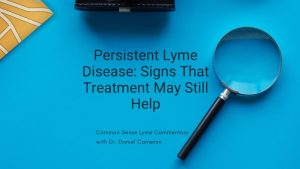Call for your appointment today 914-666-4665 | Mt. Kisco, New York

The Infectious Disease Society of America (IDSA) published evidence-based treatment guidelines in 2006 which states, “Considerable confusion and controversy exist over the frequency and cause of this process [chronic Lyme disease] and even over its existence.” Furthermore, any “[ongoing] symptoms appear to be more related to the aches and pains of daily living rather than to either Lyme disease or a tick-borne co-infection.” [1]
However, a growing number of studies are reporting treatment failures among patients whose symptoms comprise more than the aches and pains of daily living and describe significant long-term consequences of Lyme disease.
 According to a case series published in the New England Journal of Medicine, Lyme disease patients were ill up to 14 years with Lyme encephalopathy and Lyme neuropathy despite antibiotic therapy.
According to a case series published in the New England Journal of Medicine, Lyme disease patients were ill up to 14 years with Lyme encephalopathy and Lyme neuropathy despite antibiotic therapy.
There are other studies reporting treatment failure and complications after antibiotic therapy:
- 34% of a population-based, retrospective cohort were ill an average of 6.2 years after antibiotic treatment [2];
- 62% of a retrospective evaluation of 215 Lyme disease patients from Westchester County, NY, remained ill an average of 3.2 years after antibiotic treatment [3];
- 57% of 30 adults with Lyme Neuroborreliosis remained ill years after treatment at the Medical Center, University of Freiburg. [4] Read the details in another All Things Lyme blog;
- A meta-analysis of 504 patients treated for Lyme disease found this group had more fatigue, musculoskeletal pain and neurocognitive difficulties than 530 controls. [5] Additionally, it demonstrated that persistent Lyme disease symptoms were a distinct set of symptoms, which differed from those of fibromyalgia, chronic fatigue syndrome and depression; [5]
Meanwhile, four clinical trials, sponsored by the National Institutes of Health (NIH), validated the potential seriousness of Lyme disease. [6-8] The trials demonstrated that the patients’ quality of life was consistently worse than that of control populations and “was equivalent to that of patients with congestive heart failure; pain levels were similar to those of post-surgical patients and fatigue was on par with that seen in multiple sclerosis,” according to the International Lyme and Associated Diseases Society’s (ILADS) 2014 evidence-based guidelines. [9]
In an effort to help identify those patients who fail the IDSA’s recommended course of treatment, the medical society proposed a case definition for post–Lyme disease syndrome. “In an attempt to provide a framework for future research on this subject and to reduce diagnostic ambiguity in study populations, a definition for post–Lyme disease is proposed.” [1]
The proposed definition of post–Lyme disease syndrome (PTLDS) includes the following:
- A documented episode of early or late Lyme disease;
- Resolution or stabilization of the objective manifestation(s) of Lyme disease after treatment of the episode of Lyme disease with a generally accepted treatment regimen;
- Onset of any of the fatigue, widespread musculoskeletal pain, and/or complaints of cognitive difficulties within 6 months of the diagnosis of Lyme disease and persistence of continuous or relapsing of these symptoms for at least a 6-month period after completion of antibiotic therapy;
- Subjective symptoms are of such severity that, when present, result in substantial reduction in previous levels of occupational, educational, social, or personal activities. [1]
Researchers at Johns Hopkins University School of Medicine examined the incidence and severity of post-Lyme disease syndrome in Lyme disease patients who were treated early – at the time of an erythema migrans (EM) rash – with a 3-week course of doxycycline. The study confirmed the high incidence and severity of post-Lyme disease, despite a 3-week course of doxycycline. [10]
“At six months, 36% of patients reported new-onset fatigue, 20% widespread pain, and 45% neurocognitive difficulties,” according to Aucott, lead author of the study. “Patients who developed PTLDS had significantly lower life functioning compared to those without PTLDS.” [10]
“Six Lyme disease patients (10%) were subsequently re-treated for primary treatment failures, including 3 with new neurologic abnormalities documented on nerve conduction studies and 3 whose primary EM rash enlarged during antibiotic treatment,” Aucott points out.
Meanwhile, Krause stressed the importance of considering co-infections when treating patients, pointing out, “epidemiologic studies have documented that up to 40% of patients with Lyme disease experience concurrent Babesiosis.” [11]
The NIH trials demonstrated the differences in outcomes for those individuals who are treated at an early stage of the disease versus those who are not. Patients who enrolled in the Klempner trials had been ill an average of 4.7 years. [12] The Fallon trials enrolled patients who had been sick for an average of 9 years. [7]
The uniform message to Lyme disease patients has been that it is “easy to treat” and “quick to fix.” When, in fact, that is not the case. And, an increasing number of physicians are recognizing this and realizing that a one size fits all approach is not always successful in restoring a patient’s health.
References:
- Wormser GP, Dattwyler RJ, Shapiro ED et al. The clinical assessment, treatment, and prevention of lyme disease, human granulocytic anaplasmosis, and babesiosis: clinical practice guidelines by the Infectious Diseases Society of America. Clin Infect Dis, 43(9), 1089-1134 (2006).
- Shadick NA, Phillips CB, Logigian EL et al. The long-term clinical outcomes of Lyme disease. A population-based retrospective cohort study. Ann Intern Med, 121(8), 560-567 (1994).
- Asch ES, Bujak DI, Weiss M, Peterson MG, Weinstein A. Lyme disease: an infectious and postinfectious syndrome. J Rheumatol, 21(3), 454-461 (1994).
- Dersch R, Sarnes AA, Maul M et al. Quality of life, fatigue, depression and cognitive impairment in Lyme neuroborreliosis. J Neurol, (2015).
- Cairns V, Godwin J. Post-Lyme borreliosis syndrome: a meta-analysis of reported symptoms. Int J Epidemiol, 34(6), 1340-1345 (2005).
- Klempner MS, Hu LT, Evans J et al. Two controlled trials of antibiotic treatment in patients with persistent symptoms and a history of Lyme disease. N Engl J Med, 345(2), 85-92 (2001).
- Fallon BA, Keilp JG, Corbera KM et al. A randomized, placebo-controlled trial of repeated IV antibiotic therapy for Lyme encephalopathy. Neurology, 70(13), 992-1003 (2008).
- Krupp LB, Hyman LG, Grimson R et al. Study and treatment of post Lyme disease (STOP-LD): a randomized double masked clinical trial. Neurology, 60(12), 1923-1930 (2003).
- Cameron DJ, Johnson LB, Maloney EL. Evidence assessments and guideline recommendations in Lyme disease: the clinical management of known tick bites, erythema migrans rashes and persistent disease. Expert Rev Anti Infect Ther, 1-33 (2014).
- Aucott JN, Rebman AW, Crowder LA, Kortte KB. Post-treatment Lyme disease syndrome symptomatology and the impact on life functioning: is there something here? Qual Life Res, 22(1), 75-84 (2013).
- Diuk-Wasser MA, Vannier E, Krause PJ. Coinfection by Ixodes Tick-Borne Pathogens: Ecological, Epidemiological, and Clinical Consequences. Trends Parasitol, (2015).
- Klempner MS. Controlled trials of antibiotic treatment in patients with post-treatment chronic Lyme disease. Vector Borne Zoonotic Dis, 2(4), 255-263 (2002).



